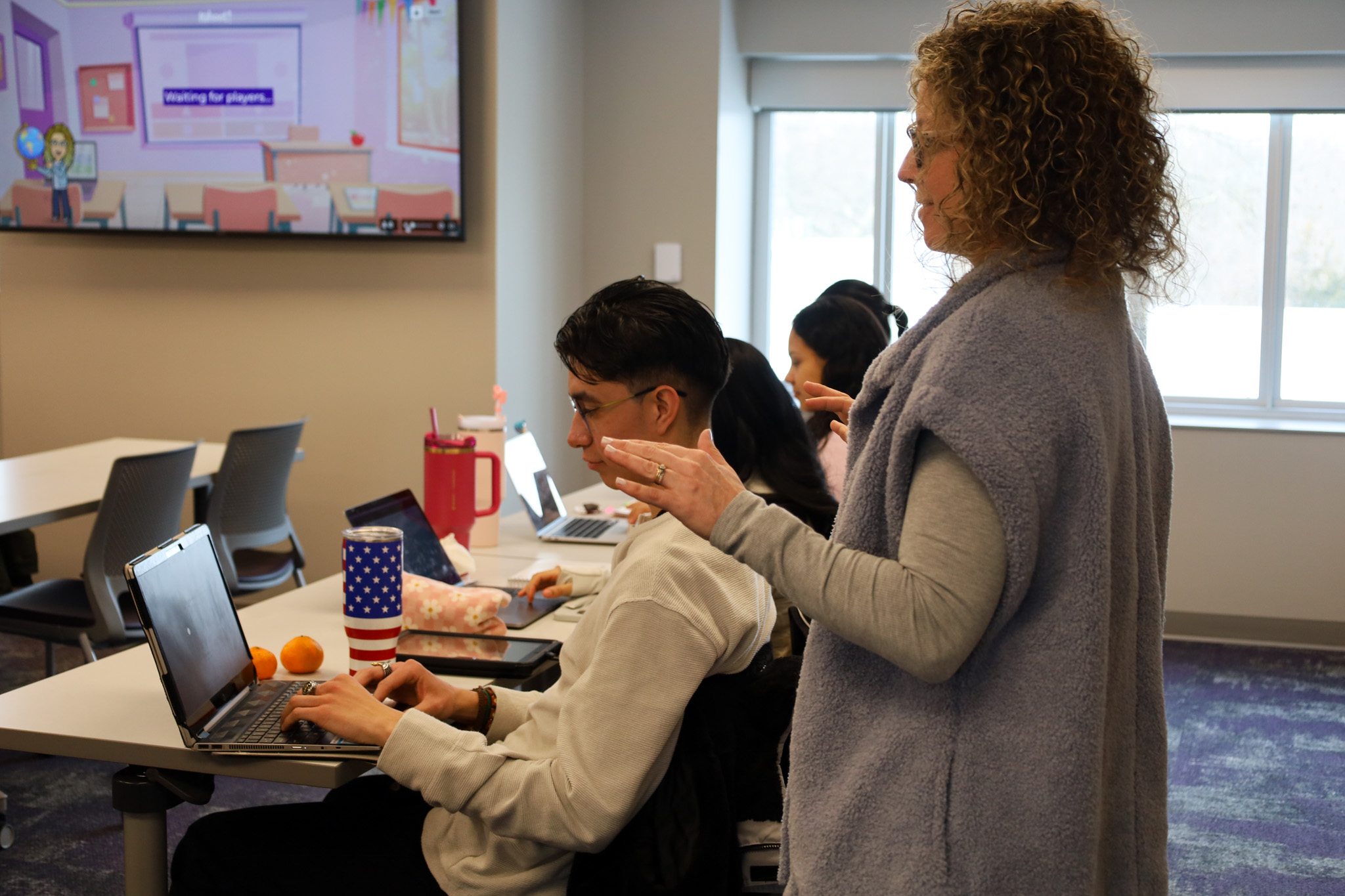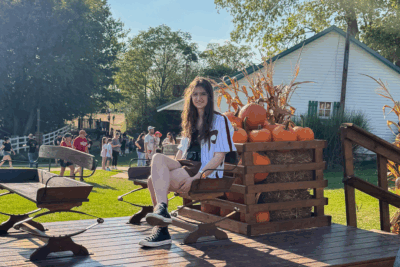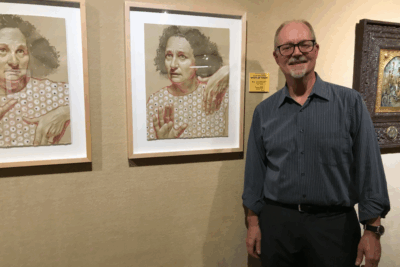The start of the spring semester marks the beginning of the first classes held in Goshen College’s brand-new Center for Nursing and Public Health. This state-of-the-art facility marks the final stage of the $21 million Westlawn Hall renovation. Nursing faculty relocated from Wyse Hall to the administrative suite, found on the second floor of Westlawn, in December, a week after students left.
The new nursing center has triple the square footage of the old space in Wyse Hall, three inpatient simulation rooms, an exam room and a 10-bed skills lab.Jewel Yoder, who is a professor of nursing, chair of the nursing department and holds a doctorate in nursing practice, said that seeing students in the space brings it to life. “[It helps me] and the other faculty remember why … we do this — What we love about this … There’s a sense of aliveness now.”
Yoder said, “My hope for [students] is that they really find this space to be much more integrative in their learning, [now] that we have these mannequins, and we can grow into practicing some really high-risk situations.”
“In the field of nursing, it’s always scary to think like, ‘What is going to happen to our patients?’” Yoder said. “What if my patient stops breathing? Well, that’s a real thing that could happen. Let’s practice that ahead of time and know what steps to take.”
Yoder said she hopes that students will feel better prepared for clinicals after working with the new equipment. “[Students] learn a lot from one another in watching each other in this space too. We don’t have that ability when you’re over at a hospital in clinical, you as a student are kind of alone with your patient. … This space, with it being sort of integrated in nature, really allows them so many more opportunities to learn from each other.”
Ella Armstrong, a first-year nursing major, said, “I’m excited to work with [the simulation mannequins] … [and be] able to get experience through that and working with, not necessarily like real people, but something similar to that and be comfortable in [that] environment.”
The three simulation rooms include one for obstetrics, an intensive care unit and a pediatric suite. With a background in a neonatal intensive care unit, Yoder said a priority for her is ensuring access to necessary resources and a healthy delivery for moms and babies. “That’s going to be a fun space … I’m really interested to see how we have [the mannequin] work and give birth.”
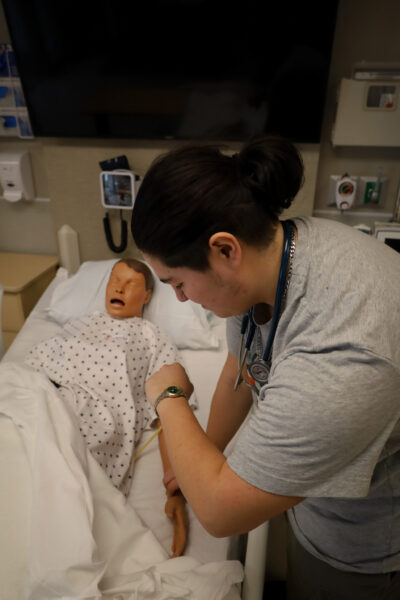 T Rodriguez takes blood pressure on new mannequin
T Rodriguez takes blood pressure on new mannequin
“The [ICU] mannequin has all sorts of bells and whistles, he can yell, scream, moan, cry at us — We can fill up his whole abdomen with all sorts of different fluids to do different things,” Yoder said. “It’s fun to have new toys and that’s exactly what this feels like. That’s what has me really looking forward to how we’ll work with students here in the spring and into the coming years.”
With all the new software-based equipment, Yoder anticipates an immediate learning curve. “There’s just lots of technology to manage and make sure that it all works — That we, as nursing faculty, know how to work it and that we’re not taking a lot of time away from student learning trying to get things set up.”
From a construction standpoint, everything is mostly finished. Brian Mast, director of facilities, said, “I went through with the architect and the contractor, DJ Construction, and we do what’s called a punch list. You go look at everything — every corner of every wall for little dings and paint or whatever. We developed a really long list, and so they’re still working on finalizing that list.”
According to Mast, construction happened over 15 to 18 months, with the planning starting another year before that. The planning process picked up when they became aware of a grant from the U.S. Commerce Department’s Economic Development Administration.
The EDA grant placed an expedited timeline on the construction project and contributed $4 million to the renovation. Mast explained that GC worked with the architecture firm Credo to create a master plan that looked at campus over the next 30 to 40 years. The Center for Nursing and Public Health was originally going to be a new building, but the EDA grant was for “shovel-ready projects.”
“We kind of pivoted and said, ‘We have all this square footage that is not being used, so let’s consider doing a project up there and utilize space that we already have on campus as opposed to adding more square footage,’” Mast said. “That part feels like being good stewards of what we have. It feels like it is right in line with kind of the Goshen College ethos of sustainability.”
One of the main goals of this project was to increase enrollment in GC’s nursing and public health programs. Yoder said, “[This new space] comes with the understanding that we are really trying to lift up all of Goshen College by having our enrollment in nursing and public health double. We’ve almost already realized that just with this incoming first-year class.”
As of the fall 2024 semester, there are 130 total students enrolled in the nursing and public health department, including undergraduate and graduate students. “As we continue to just build upon the excellent reputation that we had, we’ve been doing excellent things for such a long time and such limited space that excellence is only going to continue and grow,” Yoder said.
The admissions department already has an open house scheduled for Feb. 18 for prospective nursing students. Kellam Venosky, senior admissions counselor, said that the nursing and public health open house they have hosted for the past two years has had around 100 attendees.
Venosky said, “Admissions has really wanted to showcase all that we have to offer and I feel like with this new Westlawn renovation, both for the dining hall and nursing and public health facilities, that we’re able to really do that — showcase what Goshen College has to offer.”
Armstrong said, “I heard about this [new facility] basically on my first visit … and honestly, that was kind of a big pull for me towards here … I was looking for smaller schools but I wanted to go to one that had a growing nursing program and so I was just excited to hear about all the opportunities I would have and the new changes that would be happening.”
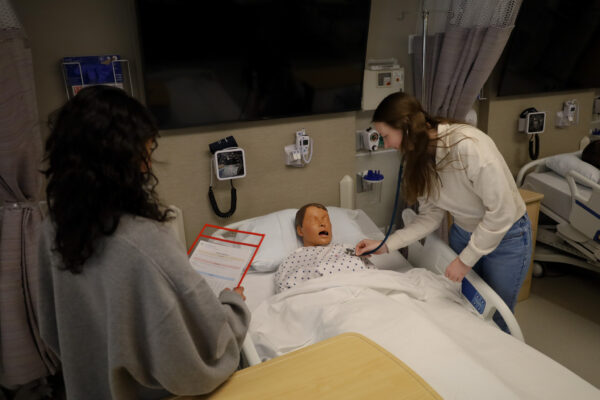 Britney Ortega and Hannah Sweitzer practice checking vitals.
Britney Ortega and Hannah Sweitzer practice checking vitals.
Hannah Sweitzer, a junior nursing major, has most of her classes in the nursing center. “It’s been really, really nice,” she said. “I actually have class in [the simulation lab] once a week and we go and we practice with the mannequins and you can turn them on — they have like breath sounds and you can feel heart rates and so that I think has been really fun because we’ll have class and we’ll talk about something, and then we’ll go to the mannequins and see it in ‘real life.’”
Sweitzer hopes that the nursing center will provide a designated space for nursing students. “That will be really nice for us just to have our own space and then I think also just more like a hands-on experience,” Sweitzer said. “I think that our professors are just really deserving of this. They’re really great and they’re really dedicated so I was I think really excited for them that they would get all these new and enhanced resources to help with their teaching.”
